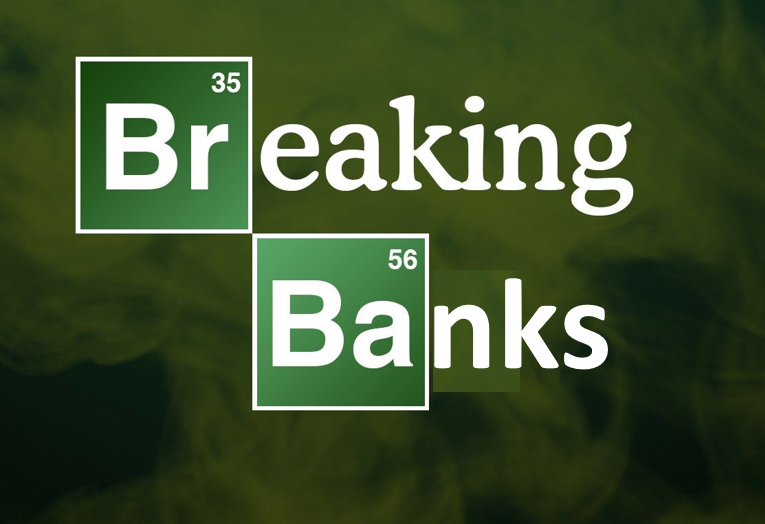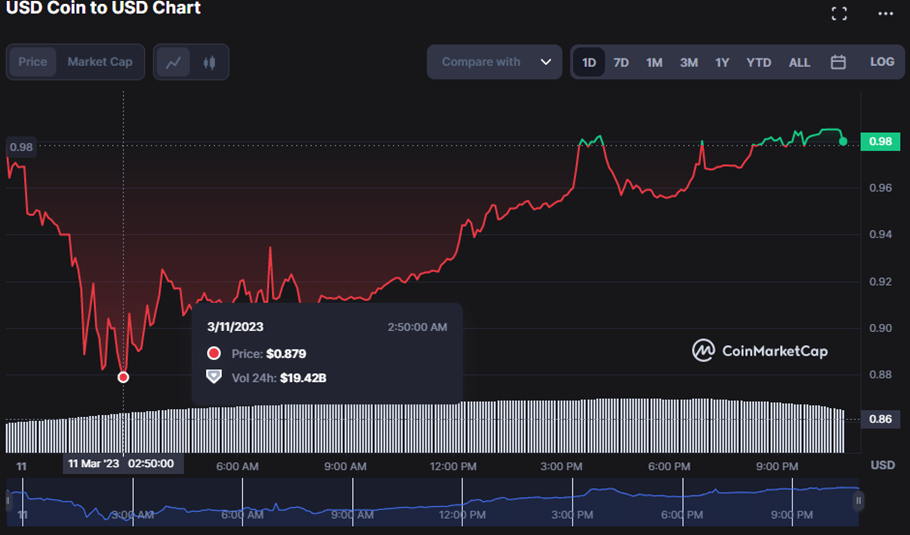Breaking Banks
U.S. Government Steps in to Quell Banking Fears
Last week we discussed the downfall of Silvergate Bank, and this week we saw two more regional banks shut their doors. Silicon Valley Bank (SVB) was the 16th largest bank in the United States, with ~$210 billion in assets, before being taken over by the FDIC on Friday. SVB catered to venture capital firms and tech startups in the technological epicenter that is Silicon Valley. Just two days later, on Sunday, the FDIC took over New York-based Signature Bank, which had ~$110 billion in assets. A vast majority of Signature’s deposits came from privately held businesses in New York. Signature was also involved in providing banking services to crypto clients and in September ’22 nearly 25% of deposits were from crypto clients.
Today, we joined the @USTreasury and @FederalReserve to take decisive actions to protect the U.S. economy by strengthening public confidence in our banking system. Read our joint statement ⤵️ https://t.co/VB0aDtfFws pic.twitter.com/nFpU76OaVP
— FDIC (@FDICgov) March 12, 2023
In response to three banks going under in a five-day timeframe the FDIC, Treasury Department, and Federal Reserve issued a joint statement to outline actions they would take to protect customer deposits in an attempt to restore trust in the banking system. The statement mentions that all depositors will be made whole and the Deposit Insurance Fund will be tapped into in order to not place losses on taxpayers.
If it was one bank, that’d be one thing.
But we’ve just seen *three* banks fail — Silvergate, SVB, and Signature. Cause of death is a combination of regulatory strangulation and bond devaluation. But these weren’t natural deaths.
The next step is to substitute artificial life… https://t.co/fSKwpKZuqz pic.twitter.com/tvokblS4EL
— Balaji (@balajis) March 13, 2023
Additionally, the Federal Reserve Board announced that they will implement the Bank Term Funding Program (BTFP) which will be “offering loans of up to one year in length” to institutions “pledging U.S. Treasuries, agency debt and mortgage-backed securities, and other qualifying assets as collateral” valued at par. This will allow banks to not have to be forced sellers of these “high-quality securities” in the current high stress environment. The BTFP will be backstopped by up to $25 billion from the Exchange Stabilization Fund from the Department of the Treasury.
$USDC Depegs Amidst Silicon Valley Bank Collapse
Circle’s USD stablecoin, $USDC, is the 5th largest crypto by market capitalization as of midnight UTC on Saturday with a market cap of ~$40 billion. On Saturday, $USDC depegged from the dollar falling under $0.88 per coin according to CoinMarketCap:
Circle used Silicon Valley Bank (SVB) as one of its banking partners, which went under on Friday. According to a blog post on Circle’s website, they held ~$3.3 billion of $USDC’s cash reserves at SVB. With the actions implemented by the FDIC, Treasury Department, and Federal Reserve mentioned above Circle should be able to recoup all of their deposits. Circle has since announced that they have entered a banking partnership with Cross River Bank and expanded their partnership with BNY Mellon. At the time of writing, $USDC has almost completely regained its dollar peg and is trading at $0.998.
Could Bitcoin be the Backbone of a New Stablecoin?
On Wednesday, Co-Founder of BitMEX and CIO at Maelstrom, Arthur Hayes, published a blog post outlining an idea for a Bitcoin based stablecoin. Below is a synopsis of Hayes’s post and how a Bitcoin-backed stablecoin, “Satoshi Nakamoto Dollar” ($NUSD), could work:
- Banks have been reluctant to offer banking services to crypto companies, after all they have to ultimate aim of syphoning off a substantial amount of the bank’s business
- McKinsey report estimated that globally, banks stand to lose $2.1 trillion in annual revenue if a successful retail CBDC is introduced
- Banks that are willing to bank crypto firms are doing so to maximize short-term profits, at the moment crypto companies are willing to pay high fees and not earn interest on their fiat deposits to secure a banking partner
- Hayes outlines the history of stablecoins, which came about to bypass the headaches caused by exchanging for fiat in the traditional banking system. Traditional banks are slow and most are confined by business hours, whereas crypto operates 24/7/365
- Stablecoins are the most liquid trading pairs on most exchanges and trading firms that use stablecoins are advantaged by not having to wait on USD wires from their corporate bank accounts
- “The point of stablecoins is not to create a decentralized product where it isn’t needed. Instead, they are simply intended to provide a fiat tokenization service the banks refuse to offer”
- Hayes makes the argument that stablecoins do not necessarily need to be decentralized, but instead offer a bridge for traders between fiat and crypto
- Math behind the Satoshi Nakamoto Dollar ($NUSD), to increase simplicity we will say the price of 1 BTC = $1:
- 1 NUSD = 1 BTC + Short 1 BTC/USD Inverse Perpetual Swap
- Bitcoin inverse perpetual swaps are paid out in BTC. When shorting the inverse perpetual swap the payoff function works as follows:
- If bitcoin doubles, the value of the position = 0.5 BTC
- If bitcoin halves, the value of the position = 2 BTC
- If BTC falls in price from $1 to $0.1 (using NUSD function above):
- Value of short BTC/USD inverse perpetual swap position 1 BTC –> 10 BTC (9 BTC profit)
- Value of NUSD = 1 BTC (initial deposit) + 9 BTC (profit from swap position) = 10 BTC
- 10 BTC * $0.1 (new BTC price) = $1
- If BTC appreciates in price from $1 to $100:
- Value of short BTC/USD inverse perpetual swap position 1 BTC –> 0.01 BTC (0.99 BTC loss)
- Value of NUSD = 1 BTC (initial deposit) – 0.99 BTC (loss from swap position) = 0.01 BTC
- 0.01 BTC * $100 (new BTC price) = $1
- NakaUSD DAO:
- $NAKA- DAO’s governance token that would bootstrap the “Sinking Fund” which would protect $NUSD from risks. Hayes highlights three potential risks that could require employment of the sinking fund:
-
- A member exchange loses BTC through theft/hacks.
- A negative funding rate. The funding rate is the mechanism that keeps the price of perpetual futures in-line with spot price; when more traders are long perpetual futures, funding is positive, so longs pay shorts funding rate to keep price in-line with spot and vice-versa when there are more shorts. Since $NUSD shorts BTC/USD inverse perpetual swaps, the sinking fund must be employed to make up the funding rate when it is negative.
- Socialized loss, which could happen if the price of Bitcoin falls hard and an exchange steps in to reduce the profit of the shorts or close a portion of the short’s position. Since the value of $NUSD relies on its short swap, these actions would leave the DAO short on Bitcoin which would be made up by the sinking fund.
-
- $NAKA holders would also be able to vote on things like member exchanges (where $NUSD’s BTC and short inverse perpetual swaps positions are held/traded) and how to spend income from the funding rate
- Historically, BTC/USD inverse perpetual swaps have had a positive funding rate a majority of the time so $NUSD would be accumulating yield if this trend continues, which would increase shareholder’s equity in NakaUSD DAO
- The DAO would have trusted Authorized Participants (APs) that would arbitrage either NUSD/USD or BTC/NUSD if $NUSD is trading at a premium/discount
- If $NUSD is trading at a premium- AP sells $NUSD and creates $NUSD to close premium and capture spread
- If $NUSD is trading at a discount- AP buys $NUSD and redeems $NUSD to close discount and capture spread
- $NAKA holders would also be able to vote on things like member exchanges (where $NUSD’s BTC and short inverse perpetual swaps positions are held/traded) and how to spend income from the funding rate
- Both $NUSD and $NAKA would be ERC-20 tokens on the Ethereum blockchain, even though $NUSD is backed by Bitcoin
ICYMI:
Binance.US Gets Green Light to Buy Voyager Digital Assets
Tensor — the ‘Blur of Solana’ — Raises $3 Million in Seed Funding
Coinbase Launches Wallet-as-a-Service for Businesses
Germany: Digital Collectible NFTs Not Securities
Before We Go:
Yesterday, The U.S. Gov’t moved ~50k Bitcoin seized from Silk Road in 2021 which got us thinking…
Who are the top known holders and how much $BTC do they own as a % of total circulating supply? pic.twitter.com/91b89gbao7
— Osprey Funds (@OspreyFunds) March 9, 2023


